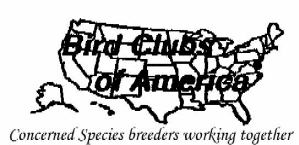In adult
females tips of the pelvic bones are usually far enough apart to
almost put a forefinger in between them, and they are rounded. Males
have very sharp tips that feel like little mountain peaks. I used the
shred and tuck method for years till now. I now have 2 males that do
this, not as well as the female but enough to have kept me fooled for
a time. All methods are infallible. If the gender of a bird has to
be known with certainty you should revert to one of the scientific
methods mentioned earlier. Almost everyone has his own way of sexing
these birds. The Peachface is a non-Eye ring species even though it does have a
very small white ring around the eye, which other non-eye rings do not.
Apparently, it's related closely enough to the other species that
hybrids are fertile. For this reason they should never
be crossbred. This ruins the gene pool of all the species involved.
***DESCRIPTION***
The Peachface lovebird is a sleek looking little
bird 6 1/2-7" in length. It has a green body, red orange face, bib,
and forehead, horn colored beak, teal rump and black flight feathers
with green on the front edge, green with black and a touch of orange
tail feathers. The females are generally larger than the males.
Average weights for a Peachface range from 45-65 grams.
***NESTING & BREEDING***
These birds breed well in both a colony or cage
situation. In a colony always make sure you have at least 1 1/2 times
as many boxes as you have pairs, double the amount of boxes is even
better. Also always place them at the same height in the flight. I
cage breed and their cages are 24" x 24" x 18". The smallest I would
put them in is 24" x 16" x 16". I use a box that's 8" x 8" x 9", hung
on the outside of the cage with a 2-3" entrance hole.
This does get a bit crowded when the female hatches out 6 babies. I
would suggest larger if you allow the birds to raise their young. I
pull mine for hand feeding between 10-17 days old. I use Carefresh
bedding but this species love willow, honeysuckle, and bayberry when I
give it to them. The hen sheds strips of paper and puts them in her
rump and under her wing feathers to carry to the nest. If given a
water bowl she will control the humidity, which is best maintained
between 50-65%. Once the
babies start to hatch I provide clean material everyday so the pair
can replenish the nest. Females should be added to the male's cage.
Never vice versa, she will kill him for entering her territory. White
eggs are laid every other day for a clutch of 4-6. The eggs begin to
hatch 18-23 (mine 23) days after incubation starts. Sometimes a hen
will not start incubating till the second or third egg is laid.
***DIET***
Their diet should consist of Pellets, Fruits, Veggies, Greens,
Pastas, Beans, Rices, and seed. If you use a pellet as a base,
meaning they eat 80% pellets, then they don't need supplemental
vitamins. If seed is used as a base then they need the vitamins.
 BCA Lovebird Genus Breeding Partnership Coordinator is
Wendy
Poole
BCA Lovebird Genus Breeding Partnership Coordinator is
Wendy
Poole
This Species Suport Page of Bird Clubs of America
, is published for its National Forum, and is produced,directed
and mailed with help from Wendy Poole, Raleigh, NC. It is sent
to BCA Alliance Clubs, but may be reproduced with full credits in
other club newsletters.
Visit Our Other Lovebird Species Breeding Partnership Sites
and become a Partner:
Fischer's Lovebird Breeding
Partnership
Madagascar Lovebird
Breeding Partnership (under re-construction)
Black-Cheeked
Lovebird Breeding Partnership
Bird Clubs of America Lovebird Partnerships

 BCA Lovebird Genus Breeding Partnership Coordinator is
BCA Lovebird Genus Breeding Partnership Coordinator is
 Breeder Articles
Breeder Articles